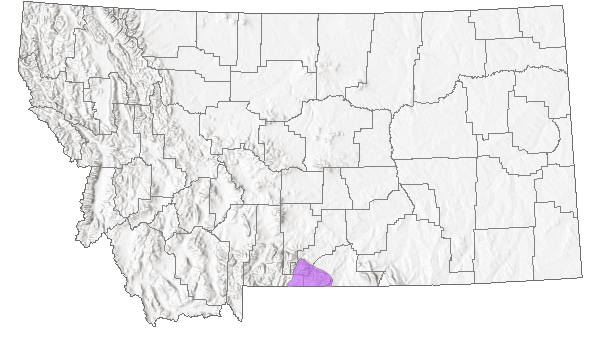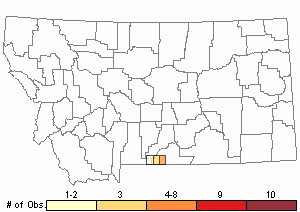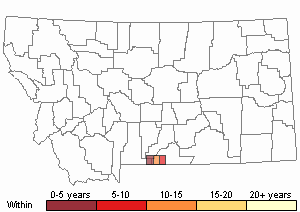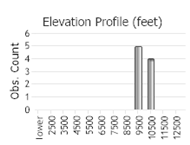View in other NatureServe Network Field Guides
NatureServe
Montana
Utah
Wyoming
Idaho
Wisconsin
British Columbia
South Carolina
Yukon
California
New York
Ice Grass - Phippsia algida
State Rank Reason (see State Rank above)
Rare in Montana, where it has been documented from only a few sites on the Beartooth Plateau. Additional surveys of suitable habitat and revisits of documented occurrences are needed to more accurately assess the species' conservation status.
General Description
Ice Grass is a glabrous perennial with fibrous roots and densely tufted stems that are up to 7 cm high. The narrow leaves have a boat-shaped tip. The 1-flowered spikelets are borne in a narrow, terminal inflorescence that is ca. 1/3 the length of the stem. Each spikelet has 2 small glumes. The thin, 3-nerved lemma is ca. 1.5 mm long and is blunt with a short point. The palea is slightly smaller and has a shallowly-toothed margin.
Phenology
Flowering and fruiting in August.
Diagnostic Characteristics
Members of the genus Poa have boat-shaped leaf tips, but have many-flowered spikelets. Species of Agrostis have 1-flowered spikelets, but the glumes are longer than the lemma. A hand lens will be required to inspect this plant.
Species Range
Montana Range
Range Descriptions

 Native
Native
Range Comments
Circumpolar; south to BC, AB and QC, south in the Rocky Mountains through MT, WY and CO (Kartesz in prep. 2012).
Observations in Montana Natural Heritage Program Database
Number of Observations: 13
(Click on the following maps and charts to see full sized version)
Map Help and Descriptions
Relative Density

Recency



 (Observations spanning multiple months or years are excluded from time charts)
(Observations spanning multiple months or years are excluded from time charts)
Habitat
Wet, gravelly soil of seeps and along streams in the alpine zone.
Ecological Systems Associated with this Species
- Commonly Associated with these Ecological Systems
Alpine Systems
Stewardship Responsibility
Threats or Limiting Factors
STATE THREAT SCORE REASON
Threat impact not assigned because threats are not known (MTNHP Threat Assessment 2021).
References
- Literature Cited AboveLegend:
 View Online Publication
View Online Publication MTNHP Threat Assessment. 2021. State Threat Score Assignment and Assessment of Reported Threats from 2006 to 2021 for State-listed Vascular Plants. Botany Program, Montana Natural Heritage Program, Helena, Montana.
MTNHP Threat Assessment. 2021. State Threat Score Assignment and Assessment of Reported Threats from 2006 to 2021 for State-listed Vascular Plants. Botany Program, Montana Natural Heritage Program, Helena, Montana.
- Additional ReferencesLegend:
 View Online Publication
View Online Publication
Do you know of a citation we're missing? Clark, T.W., H.A. Harvey, R.D. Dorn, D.L. Genter, and C. Groves (eds). 1989. Rare, sensitive, and threatened species of the greater Yellowstone ecosystem. Northern Rockies Conservation Cooperative, Montana Natural Heritage Program, The Nature Conservancy, and Mountain West Environmental Services. 153 p.
Clark, T.W., H.A. Harvey, R.D. Dorn, D.L. Genter, and C. Groves (eds). 1989. Rare, sensitive, and threatened species of the greater Yellowstone ecosystem. Northern Rockies Conservation Cooperative, Montana Natural Heritage Program, The Nature Conservancy, and Mountain West Environmental Services. 153 p. Fertig, W. and M. Bynum. 1994. Biological report on the proposed Twin Lakes Research Natural Area. Unpublished report to the Shoshone National Forest. Wyoming Natural Diversity Database, Laramie, Wyoming. 33 pp. plus appendices.
Fertig, W. and M. Bynum. 1994. Biological report on the proposed Twin Lakes Research Natural Area. Unpublished report to the Shoshone National Forest. Wyoming Natural Diversity Database, Laramie, Wyoming. 33 pp. plus appendices. Grulke, N. E. and L. C. Bliss. 1983. A note on winter seed rain in the High Arctic. Arctic and Alpine Research 15(2):261-265.
Grulke, N. E. and L. C. Bliss. 1983. A note on winter seed rain in the High Arctic. Arctic and Alpine Research 15(2):261-265. Grulke, N. E. and L. C. Bliss. 1988. Comparative life history characteristics of two high Arctic grasses, Northwest Territories. Ecology 69(2):484-496.
Grulke, N. E. and L. C. Bliss. 1988. Comparative life history characteristics of two high Arctic grasses, Northwest Territories. Ecology 69(2):484-496. Grulke, N.E. 1995. Distribution of Phippsia algida and autosuccession in the polar semidesert, Canadian High Arctic. Arctic and Alpine Research 27(2):172-179.
Grulke, N.E. 1995. Distribution of Phippsia algida and autosuccession in the polar semidesert, Canadian High Arctic. Arctic and Alpine Research 27(2):172-179. Lesica, P. 1993. Vegetation and flora of the Line Creek Plateau area, Carbon County, Montana. Unpublished report to USDA Forest Service, Intermountain Research Station. Montana Natural Heritage Program, Helena, Montana. 30 pp.
Lesica, P. 1993. Vegetation and flora of the Line Creek Plateau area, Carbon County, Montana. Unpublished report to USDA Forest Service, Intermountain Research Station. Montana Natural Heritage Program, Helena, Montana. 30 pp. Lesica, P., M.T. Lavin, and P.F. Stickney. 2012. Manual of Montana Vascular Plants. Fort Worth, TX: BRIT Press. viii + 771 p.
Lesica, P., M.T. Lavin, and P.F. Stickney. 2012. Manual of Montana Vascular Plants. Fort Worth, TX: BRIT Press. viii + 771 p. Lesica, P., M.T. Lavin, and P.F. Stickney. 2022. Manual of Montana Vascular Plants, Second Edition. Fort Worth, TX: BRIT Press. viii + 779 p.
Lesica, P., M.T. Lavin, and P.F. Stickney. 2022. Manual of Montana Vascular Plants, Second Edition. Fort Worth, TX: BRIT Press. viii + 779 p.
- Web Search Engines for Articles on "Ice Grass"





